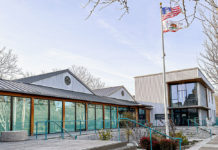Counties in the purple will have to distance learn, a move to red can reopen schools
Last month Gov. Gavin Newsom and the California State Department of Public Health (CDPH) announced a new state COVID-19 monitoring system for counties that involves four color-coded tiers related to coronavirus spread. The tiered system dictates how specific business sectors can operate. For school districts, the monitoring system addresses when and how schools will be allowed to open for in-person learning. Counties like Sonoma County that are in the purple tier — the most severe tier that denotes a widespread presence of coronavirus — cannot be open for in-person learning and must stay in distance learning.
Once a county moves from purple into the red tier and has been in the tier for at least two weeks then school districts, private and charter schools can move to some form of in-person learning, whether it be hybrid learning or full-time in-person learning. Counties in the purple exhibit greater than seven new cases per 100,000 people per day based on a seven-day average and have a greater than 8% testing positivity rate
With this new system called a “Blueprint for a Safety Economy,” K-6 schools in counties that are in the purple tier can still apply for a waiver for in-person learning with their local health officer.
State Superintendent Tony Thurmond, State Epidemiologist Dr. Erica Pan and Cabinet Secretary to the governor’s office Ben Childa held a Zoom and Facebook Live session on Sept. 9 to discuss the new state monitoring system in relation to schools and safe cohorts for students with disabilities.
With the old monitoring system, counties were either on or off the state coronavirus watchlist which prescribed whether or not schools in counties could open. Metrics that measured if a county was on the watchlist or not included case rates, testing percent positivity, the number of COVID patients hospitalized and the number of ventilators and personal protective equipment available. If a county met a certain case rate threshold and met the other metrics, then it would be placed on the watchlist.
“Counties were either on this list or off this list and when they were on, it meant that we were doing more engagement with them trying to see what other containment and mitigation effort needed to happen in those places. What we found and as we were thinking about lessons learned from the shelter in place in March (when) we wanted to start to allow for things to recur, but we did learn our lesson that we allowed that to happen too quickly,” Pan said.
Now with the tiered-system, health officials can better monitor a county’s progress which will dictate what activities can be done safely and what industries can remain open indoors or outdoors.
“The goal this time around is to do a few things, to not just have on and off, but have a progressive and phased approach so that there are different categories that each county will fall into as far as what we are categorizing the level of disease transmission that they are seeing, and concurrently with that, what kinds of activities do we think are as safe as possible to allow in that sector,” Pan explained.
With this new system counties have to be in each phase for at least three weeks before they can move forward into the next tier. The new framework is based on case rates and percent positivity and if those numbers increase again after a county has moved into the next phase then it would have to move back into the previous, more stringent phase that it was in previously.
A health equity metric will also be added to the criterion in the next few days and counties will also have to meet that metric before moving into the next phase. The different tiers include purple/widespread, red/substantial, orange/moderate and yellow/minimal spread.
Counties in the purple tier exhibit greater than seven new cases per 100,000 people per day based on a seven-day average and have a greater than 8% testing positivity rate.
In how this related to schools, Pan said, “The purple tier, the widespread one, is essentially the same criteria based on case rates and percent positivity as the data monitoring list, so the same principles will apply that once a county has been outside of that purple tier and into the red tier for at least two weeks that is when schools can reopen.”
According to Pan, if a school has just returned to in-class or hybrid learning and soon after that the county the school is in returns to the purple tier then the school would have to pivot back to distance learning.
“This is a challenging time for all of us and I can speak to this as a parent and as a public health official,” Pan said. “We really want to do our best to continue the great progress we’ve made in California with decreasing cases by doing this (blueprint for a safer economy) slowly and carefully.”
Sonoma County is still in the purple tier. As of Sept. 10, the county has 2,071 active cases, which is 0.41% of the population. 4,347 cases, about 67%, have recovered and there is a total of 98 deaths. The total case count according to county data is 6,516, an increase of 28 in the last 24 hours. The case rate total is 1.28% of the population.
Cohort guidance
For students with disabilities or special needs students who need in-person instruction services and care, Pan said schools could open for these students if students received instruction in a stable cohort of 16 people.
Pan made it clear that schools cannot use this as a way to fully reopen and that this would only be for students with disabilities and students who are in need of instruction in real time.
“We do want to make sure that special needs children, a very small number of those, could come back to some in-person instruction,” she said.
She said at first the cohort number was 14 students and two adults, however, after feedback from folks they set the number at 16.
“We got a lot of feedback from the community that we needed to have a little more flexibility about that … from a public health standpoint the main principle is that smaller cohorts are better, but up to 16 is very reasonable. You want to have a safe ratio, both from a public health and a supervision and educational perspective, of adults to children,” Pan said. She said cohorts will not be allowed to mix in order to maintain safe and stable cohorts.








